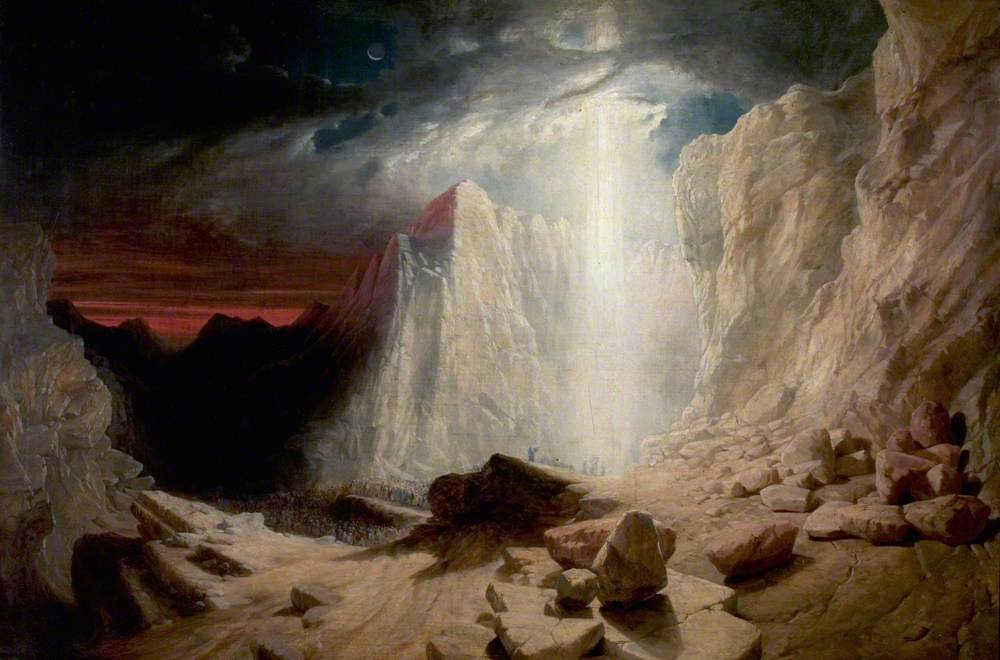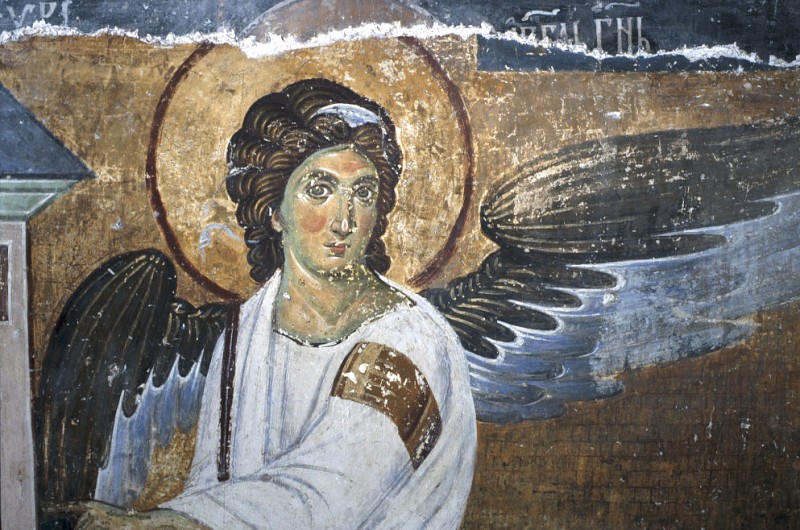This article is part of a series on Old Testament Christophanies. For important background information, see An Introduction to Old Testament Christophanies–with Justin Martyr.

The Lord’s instructions from Sinai included a promise that the Angel would lead the Israelites into the Promised Land:
“Behold, I am going to send an angel before you to guard you along the way and to bring you into the place which I have prepared. Be on your guard before him and obey his voice; do not be rebellious toward him, for he will not pardon your transgression, since My name is in him” (Exod 23:20–21).
Since the Angel wouldn’t pardon the Israelites’ transgression, we should infer that He had the authority to. No ordinary angel has the authority to forgive sins, while Jesus Christ certainly does (Matt 9:6). The name being in the Angel meant that He was intimately united with the Lord. The Lord’s name, Yahweh, is descriptive of His fundamental nature. He has stated, “I am the LORD, that is My name; I will not give My glory to another” (Isa 42:8a). Never has His name been set in a created being, while it is forever in His Son.
In the High Priestly Prayer, Jesus said to the Father, “I have manifested Your name to the men whom You gave Me out of the world” (John 17:6a). Jesus made known the whole character of the Father to His disciples. In other words, He revealed God to them.
After Jesus told Philip that He who had seen Him had seen the Father (John 14:7), He went on to declare that the Father was in Him:
“Do you not believe that I am in the Father, and the Father is in Me? The words that I say to you I do not speak on My own initiative, but the Father abiding in Me does His works. Believe Me that I am in the Father and the Father is in Me” (John 14:10–11a).
Whether before the incarnation or after, Jesus has always had full authority from the Father. The Father and Son being in one another means that they share in the same divine substance; they are one (John 10:30). Along with the Holy Spirit, they make up the one Godhead.
Through the rest of Exodus 23, the line between Yahweh and the Angel is blurred. If the Israelites obey the Angel’s voice and do all that the Lord says, then it is the Lord who will be an enemy to their enemies (v. 22). The Angel would go before the Israelites into the land, while it is the Lord who would destroy them (v. 23). Then, in verse 25, the Lord says that the Israelites shall serve “the LORD your God,” and “He” will bless their bread and water; and “I” will remove sickness from their midst. What we have here is the Lord referring to different members of the Godhead. By abiding in the Son, the Father does His works.
It is confirmed that the Angel would go before the Israelites in Exodus 32:34 and in 33:2. Then, in Exodus 33:14–15, the Lord said that His “presence” would go with them. Isaiah 63:9 helps us to make sense of these passages, by referring to the Exodus Angel with a special name: the Angel of His Presence (or the Angel of His Face). The Angel was nothing less than the embodiment of Yahweh’s presence among the Israelites. We also read in the verse that the Angel was a savior to His people.
Philo said that the Angel in Exodus 23:20–21 was the divine Logos, whose role is to guide men.[1] The view that Yahweh’s name being in the Angel identifies Him as the second person of the Trinity is common in Christian commentaries. For example, the English theologian Matthew Poole (1624–1679), asserted that
it is unreasonable to think no more is ascribed to this Angel; but that his Divine nature or essence is in him, whence he is called the Lord our Righteousness, Jer. xxiii.6; and God, who will not give his glory to another, Isa. xlii. 8, hath given it to Christ, that all men should honour the Son even as they honour the Father, John v. 23, which never was nor can be said of any angel without blasphemy.[2]
Metatron?
Exodus 23:20–21 is among the cardinal passages where rabbinic tradition has identified the angel mentioned in them as Metatron. The meaning of his name is unclear, though some argue it means “behind the throne,” while others say it means “arranger,” “divider,” or “representative.” Some see importance in the name Metatron being numerically equivalent to God’s name Shaddai (typically translated as “Almighty”) in Hebrew Gematria (the alphanumeric code by which letters correspond to numbers).

Alfred Edersheim, raised in traditional Jewish schooling before becoming a Christian scholar, summarized who Metatron is and several of his key appearances in the literature:
Metatron, who appears most closely to correspond to the Angel of the Face, or the Logos. He is the representative of God. In the Talmud (Sanh. 38b) a Christian is introduced as clumsily starting a controversy on this point, that, according to the Jewish contention, Exod. xxiv. 1 should have read, ‘Come up to Me.’ On this R. Idith explained that the expression referred to the Metatron (Exod. xxxiii. 21), but denied the inference that Metatron was either to be adored, or had power to forgive sins, or that he was to be regarded as a Mediator. In continuation of this controversy we are told (Chag. 15a, b) that, when an apostate Rabbi had seen Metatron sitting in heaven, and would have inferred from it that there were two supreme powers, Metatron received from another angel 60 fiery stripes so as to prove his inferiority! In Targ. Ps-Jon. on Gen. v. 24 he is called the Great Scribe, and also the Prince of this world. He is also designated as ‘the Youth,’ and in the Kabbalah as ‘the little God,’ who had 7 names like the Almighty, and shared his Majesty. He is also called the ‘Prince of the Face,’ and described as the Angel who sits in the innermost chamber (Chag. 5b), while the other angels hear their commands outside the Veil (Chag. 16a). He is represented as showing the unseen to Moses (Siphré, p. 141 a), and as instructing infants who have died without receiving knowledge (Abhod. Zar. 3b). In the introduction to the Midrash on Lamentations there is a revolting story in which Metatron is represented as proposing to shed tears in order that God might not have to weep over the destruction of Jerusalem, to which, however, the Almighty is made to refuse His assent . . . In Siphré on Deut. . . . Metatron is said to have shown Moses the whole of Palestine. He is also said to have gone before Israel in the wilderness.[3]
Metatron came to be merged in the literature with the archangel Yaho’el and translated Enoch.[4] In verse 12:5 of the pseudepigraphal book of 3 Enoch and in b. Sanhedrin 38b in the Talmud, the angel of Exodus 23:20–21 is identified as Metatron. Yahweh’s name being in Metatron led him to be called “the lesser YHWH” in 3 Enoch 12:5. And in b. Sanhedrin 38b, Metatron’s name is said to be “like the name of his Master.” In one Targum, Metatron (or an angel much like him) is named “Zagnugael, the angel of the Lord,” and it is he who appeared in the burning bush.[5] Fruchtenbaum stated that Metatron “became the rabbinic explanation for the Angel of YHWH of the Hebrew Bible.”[6]
Metatron is clearly portrayed as highly exalted, while still being placed lower than God. The rabbis were trying to strike a balance, as it were, where they could explain why an angel was treated as Yahweh without actually being Yahweh. Despite their efforts, appealing to an angel that is never mentioned in Scripture to understand the divine Angel, whether it be in Exodus 23 or elsewhere, lacks respect for God’s Word. However, in some ways, the rabbis were close to the truth. The Angel in Exodus 23, and the Angel of the Lord in general, is highly exalted and He is rightly called Yahweh. While He certainly isn’t a lesser Yahweh, He is a Yahweh distinct from the Father. He is Yahweh the Son.
Again, the Lord doesn’t give His glory to another (Isa 42:8). The Angel in Exodus 23 isn’t an extra-biblical angel, such as Metatron or Yaho’el, nor is He a created one from the Bible, such as Michael or Gabriel. He is the Angel of His presence, the Angel of Yahweh, the Son of God.
[1] Philo, De Migratione Abrahami 174.
[2] Poole, Annotations, 1:169.
[3] Edersheim, appendix 13 in Life and Times, 2:750.
[4] Charlesworth, ed., The Old Testament Pseudepigrapha, 1:244.
[5] Targum Pseudo-Jonathan on Exodus 3:2.
[6] Fruchtenbaum, Yeshua, 1:267.

Your article has an unsubstantiated plethora of conjecture that is easily rebuttable by a clear reading of the text without a connection the dots narrative.
You may not agree. However, the article uses plenty of source citations and is part of a series that uses a total of thousands of citations. What specifically do you find inaccurate?
I’m trying to collect the names of God. Does the Angel mentioned in Exodus 23:20 actually have a specific name ?
Not as such.
Don’t quote me
I believe that his name was Yahway. (spelling, not quite sure)